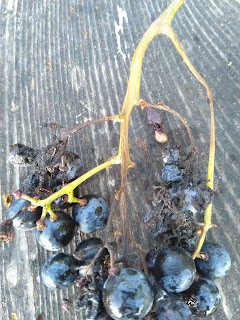 |
| Sour rot on a grape cluster. Photo: Annie Klodd |
Author: Annie Klodd, UMN Extension Educator - Fruit Production. kloddann@umn.edu
A few shriveled and rotten berries are a normal site during the harvest season. If you spot more than a few, find out what the cause is before deciding what to do about it.
Each fruit rot disease has slightly different symptoms (described below). Based on the symptoms, we can usually make an educated guess about the disease or disorder. If we cannot identify it from visual symptoms, the next step would be to mail a sample to the Plant Disease Clinic for official diagnosis.
We recommend against spraying the grapes unless you know the disease infecting the grapes and what is effective on it. Additionally, know the pre-harvest
interval, cause, and the cost & benefit of spraying, before
spraying anything. Remember that each application cuts into the revenue per acre, so each spray needs to be worth the money and environmental risk.
Vineyards and Master Gardeners may send me photos to help with
diagnosis. Home gardeners should contact Ask a Master Gardener.
 |
| Phomopsis (Diaporthe ampelina) on a grape cluster. Photo submitted by grower. |
Symptoms of four major harvest-time cluster rots in Minnesota:
- Botrytis grey mold: The berries have gray fuzzy fungal growth and are turning soft. The pedicels and rachises (cluster stems) are green.
- Sour rot:
The berries are rotting but do not have fuzzy growth. They may have
holes, appear wet, and have a vinegar smell. Associated with bird
feeding damage and fruit flies. The pedicels and rachises are green.
- Phomopsis (i.e. Diaporthe ampelina) (see photo above):
The berries are soft and desiccating. The pedicels and rachises have
black/brown lesions and are desiccating as well. The canes probably have
lesions, too.
- Bunch stem necrosis (BSN): Some of the berries are soft and desiccating. They declined suddenly. The rachises and pedicels associated with the soft berries are dried up all the way around (as opposed to having brown spots and lesions). There are no disease lesions on the rachises or canes. Bunch stem necrosis is not a disease, it is a physiological disorder that cannot be controlled by fungicides. Spraying fungicides for this problem will only hurt your revenue, with no benefit.
 |
| Bunch stem necrosis on a grape cluster. Photo: Annie Klodd |
 |
| Botrytis grey mold on a Marquette cluster. Photo: Drew Horton. |
Taking action:
After identifying and reading up on the problem, decide what action to take. Options include:
- Move the harvest date up. This strategy might be used for rots that are serious and spreading. Consider this if the crop may be lost if you wait, and if the berries are ripe enough to be usable. This may be the best move for bunch stem necrosis, which is thought to get worse as the berries ripen. If the berries are slightly under-ripe, consult with your winemaker about using them for sparkling wine. If they are seriously under-ripe, consider a different option.
- Remove the infected berries. Small botrytis infections can be slowed by removing the infected berries. This strategy is less immediately effective for phomopsis, which spreads from lesions on the canes and pedicels. It is good to remove sour rot-infected berries for wasp control, but it will not prevent further bird damage. Removing BSN grapes will not accomplish anything because there is no pathogen involved.
- Improve your bird management strategy. Sour rot often occurs at the site of bird feeding. You can stop the spread of it by applying or repairing holes in bird netting, or otherwise improving your bird control measures.
- Spray the vines with an effective, low PHI pesticide. Only
consider this option if you know what is causing the problem, and know
which products are effective on it. Sour rot is managed with a
combination of an insecticide and bactericide, for example, while
botrytis requires certain fungicides. Choose products with minimal pre-harvest intervals (PHI). Use the Midwest Fruit Pest Management Guide or Growing Grapes in Minnesota for pesticide recommendations.
- Leave the berries alone. If the infection is small, it may be best to leave it alone for now while keeping a close eye on any spread.
Some examples of short-PHI pesticides commonly used during harvest
include: Captan, Elevate, Oxidate, phosphorous acid, Serenade, and
Switch 62.5 WGD Always read the label before applying these pesticides - the label is the law, and the information provided in this article is not all-inclusive.
- Captan: Protectant that should be sprayed prior to a rainfall event. Not effective on powdery mildew.
- Elevate: Systemic protectant effective on botrytis and powdery mildew.
- Oxidate: Broad spectrum curative product commonly used for bunch rots. It has some efficacy on sour rot, a bacterial infection.
- Phosphorous acid: Protectant and curative efficacy on downy mildew
- Serenade: Biofungicide used as a protectant for various diseases. Efficacy is not well studied.
- Switch 62.5 WGD: Used as protectant for bunch rots
Comments
Post a Comment